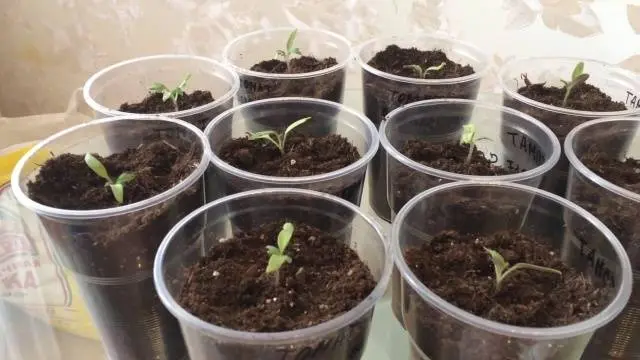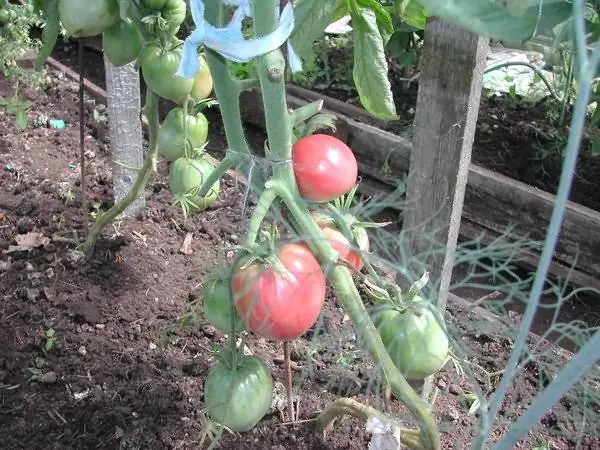Contents
Round, even, medium-sized tomatoes are, of course, good: it is these fruits that look best in jars and look attractive on the counter. But every gardener still wants to grow the largest tomatoes on his plot, because they are fragrant, juicy and very fleshy – fruits for salads and juices. It is such a large-fruited variety that the Cow’s Heart tomato is.
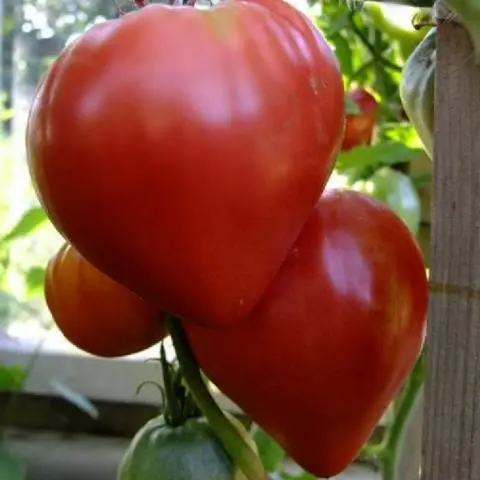
From this article, you can learn about the yield of the Cow’s Heart tomato, see photos of its fruits, read the reviews of those who planted this miracle on their site. Here is a description of the various subspecies of the Cow’s Heart variety, recommendations for growing and caring for plants.
More details about varieties
First of all, it is worth noting that the characteristics and description of the Cow’s Heart tomato variety differ from the Bull’s Heart tomato: these are two completely different varieties. Although the fruits of these varieties, indeed, have an external resemblance and almost the same taste. The main difference between the two species is the height of the bush and the size of the fruit: after all, the Bull’s Heart is larger in all respects.

The tomato variety Volovye Heart was bred in Our Country in 2000, at the same time it was entered into the State Register. This tomato is considered late-ripening, although some breeders classify it as a medium-ripening tomato. Therefore, it is recommended to grow this variety in the southern and central regions; in the North, the Heart is planted only in a greenhouse.
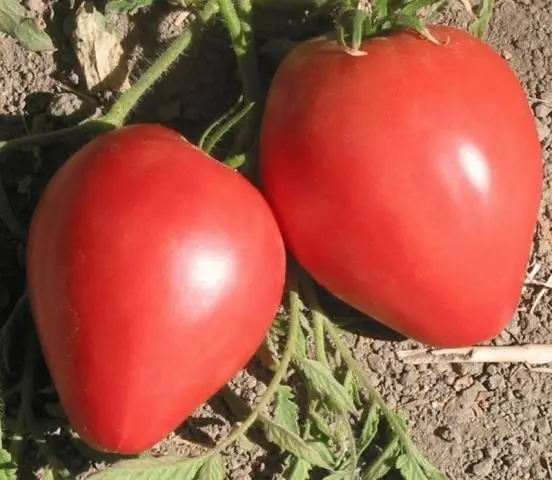
Description of the tomato variety Cow’s Heart:
- bushes of indeterminate type, their height in the greenhouse reaches two meters, in open ground – no more than 170 cm;
- tomatoes ripen in 107-118 days from the moment of germination;
- there are not very many leaves on the bushes, they are of medium size, of the usual form;
- the yield of a tomato in open ground is not very high – up to 7 kg per square meter, in a greenhouse it is realistic to raise this figure to 11 kg;
- variety Volovye Heart has a complex resistance to “tomato” diseases, including late blight;
- the tomato responds well to fertilizers and regular watering;
- the first flower ovary is usually located above the seventh leaf;
- up to five tomatoes can form in each brush;
- the average fruit weight is 350 grams;
- the lower tomatoes reach sizes of 800-1000 grams, the upper ones are smaller – 250-150 grams;
- the shape of the fetus resembles a heart – an elongated ribbed oval;
- the color of the tomatoes is raspberry red;
- the pulp is sugary on a break, tasty, very sweet, fragrant;
- tomatoes are suitable for transportation, as they have a dense peel, their pulp contains a lot of dry substances;
- the harvested crop will not be stored for long, so you need to quickly sell the fruits;
- the root system of this variety is very powerful – the length of the central horse can reach a meter, the side roots often branch out 2-2,5 meters from the middle of the bush.
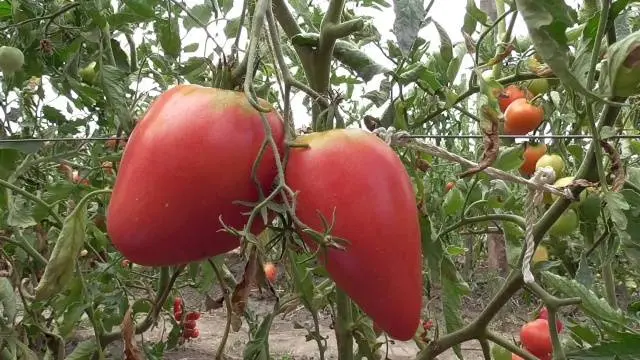
Variety Ox Heart is considered salad, that is, it is best to eat fresh tomatoes. These tomatoes make delicious purees, pastes and juices. From one kilogram of fruit comes out 700 ml of tomato juice. In general, it will not work to preserve the Cow’s Heart tomato, since its dimensions are quite large. But in pickled salads and appetizers, the tomato looks great.
Advantages and disadvantages
The Ox Heart variety is rather ambiguous: the opinions and reviews of gardeners about this tomato are the most controversial. Therefore, it is worth highlighting the strengths and weaknesses of the Heart.

Of the benefits can be called:
- impressive fruit size;
- high-quality tomato appearance;
- excellent taste of tomatoes;
- good yield (with sufficient care);
- medium resistance to diseases (which is very important for a late-ripening variety).
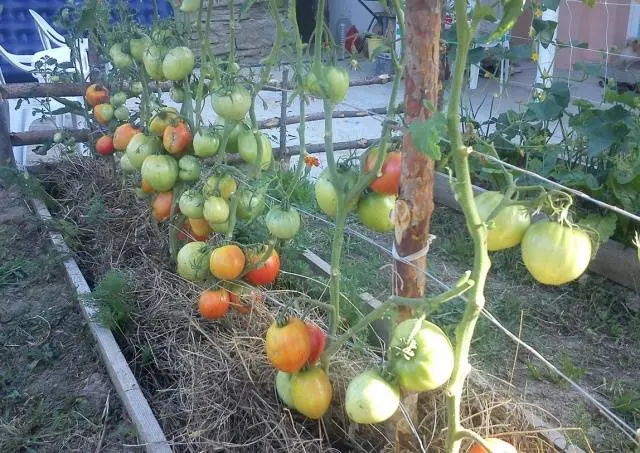
The cons of a heart-shaped tomato are also available:
- plants need constant and competent care;
- the variety has a long growing season, which is not suitable for every climate;
- for the Cow’s Heart, the temperature regime is very important – the tomato does not like fluctuations from heat to cold;
- it will not be possible to preserve the crop for a long time – the fruits quickly deteriorate.
Variety subspecies
Of course, the tomato in question cannot boast of as many varieties as its counterpart, the Ox Heart variety (there are pink, striped, black-fruited tomatoes and many other species). But the Cow’s Heart also has a couple of popular varieties among the people:
Tomato Minusinskoye Ox’s Heart
Brought folk breeders. It differs from its predecessor in earlier ripening (mid-ripening variety), slightly reduced fruit weight (limits from 200 to 400 grams are indicated), a small amount of seeds inside tomatoes. It is recommended to grow this variety in two or three stems.

Cow’s Heart Striped
It is easy to recognize by the appearance of the fruit: the tomatoes are golden-pink in color, yellow-green stripes are clearly visible on the peel. Tomatoes are smaller than those of the predecessor variety – 150-200 grams, but they are very sweet and tasty. It is recommended to grow this subspecies in protected ground. Its ripening period is average, the bushes are not so high (up to 130 cm).
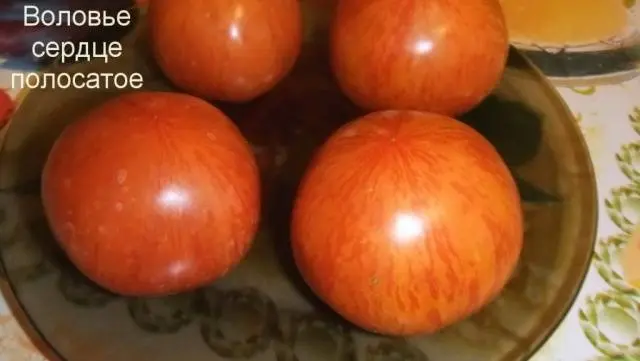
Growing rules
To harvest a good harvest of large and beautiful fruits, the gardener will have to work hard – Cow’s Heart loves attention and care. In principle, like most large-fruited late-ripening tomatoes, this tomato prefers well-heated light soils with a sufficient content of trace elements. Do not forget about the indeterminacy of the bush – the tomato will have to be formed, regularly pinched and control the number of ovaries.
Those who decide to start this variety of tomato in their garden are recommended to do the following:
- Find on sale or grow your own strong and healthy seedlings. Seeds for seedlings are sown in March – the exact dates depend on the climate in the region and on where the tomatoes will be grown (soil or greenhouse). It is necessary to calculate the landing so that by the time the plants were transferred to a permanent place, they were from 55 to 65 days old.
- First, the seeds can be sown in a common container with small sides. When a tomato has a couple of leaves, they are seated in individual pots.

- Before transplanting into the ground, the plants are hardened by taking them outside or onto a balcony with open windows.
- Like all indeterminants, the Heart takes up a lot of space in the greenhouse and in the garden. To give freedom to the bushes, seedlings are planted according to the scheme 50×70. Do not bury the roots of tomatoes deeper than 20 cm – they do not like the cold. The temperature of the soil at such a depth should be more than eight degrees.
- Immediately you need to take care of the supports for the tomato. Tapestries are most suitable, but you can also build supports from wooden pegs.

- It is recommended to form a bush in one or two stems. The second stem is released from the stepson, which is located immediately above the first ovary.
- All other stepchildren should be removed regularly. Extra ovaries also need to be cut off – on one bush there should be no more than 6-8 fruit brushes. If you do not thin out the brushes, the tomatoes will grow small and tasteless.
- Tomatoes need to be fed 3-4 times during the summer. For these purposes, mineral and organic fertilizers are used. Potassium-phosphorus compounds work well, a small amount of nitrogenous top dressing is acceptable.

- Water the Heart often and plentifully (every three days) This tomato loves water. In order not to expose the bushes to the risk of infection, the water is used warm, the soil is mulched, and the lower leaves of the tomatoes are cut off to improve air circulation.
- Although the variety is considered resistant, bushes still need to be processed in order to prevent diseases. If there are no visible signs of infection, Bordeaux liquid or any chemical agent is used. It is necessary to process the bushes before they begin to bloom.
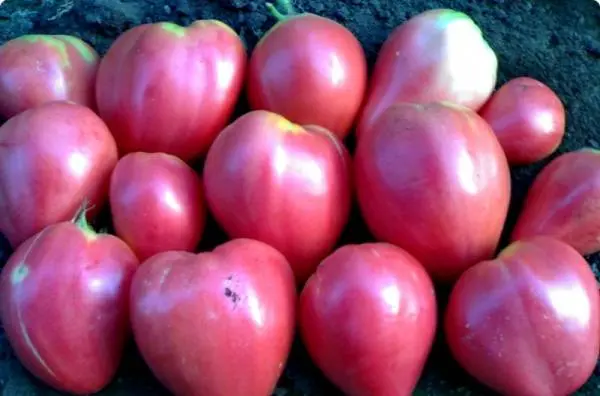
Review of the gardener
Conclusion
Cow’s Heart tomato is not suitable for all gardeners: this tomato needs a warm climate or a greenhouse, it needs nutritious soil and space, the farmer must know how to deal with bushes that have an unlimited growing point. But in return for all its “whims”, the tomato will give the gardener a generous harvest of one of the largest and most delicious fruits. So it might be worth the effort!










